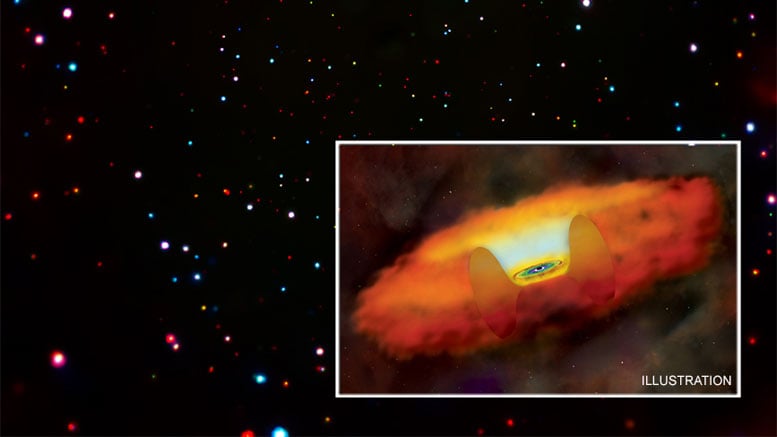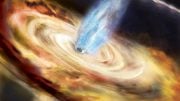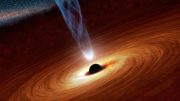
The artist’s illustration depicts gas falling onto an actively growing black hole via a disk. While X-rays from this disk can penetrate the cocoon of material surrounding the black hole, few if any from beyond 13 billion light years have been found in long Chandra observations. This indicates these very distant black holes in this period may grow quickly but only for short periods of time. Credit: NASA/CXC/M.Weiss
By comparing theoretical models to Chandra surveys and the Sloan Digital Sky Survey, astronomers have found evidence that the very earliest supermassive black holes in the Universe may have grown in intense and sporadic bursts.
New research using NASA’s Chandra X-ray Observatory and the Sloan Digital Sky Survey (SDSS) suggests supermassive black holes in the early Universe underwent sporadic yet intense periods of growth in the first billion years after the Big Bang. Scientists determined this by comparing theoretical models to data from the Chandra Deep Field-South (CDF-S), the deepest X-ray image ever obtained, and other Chandra surveys. This central region of the CDF-S, where red, green, and blue represent low, medium, and high-energy X-rays detected by Chandra, is seen in the main panel.
When material is falling toward a black hole, it becomes heated, and produces large amounts of electromagnetic radiation, including copious X-ray emission. The artist’s illustration in the inset depicts gas falling onto an actively growing black hole via a disk. X-rays from this disk can penetrate the cocoon of material surrounding the black hole. Rapidly growing black holes in the very early Universe should be detectable with Chandra. However, these growing supermassive black holes have proved to be elusive, with only a few, yet-to-be-confirmed candidates found in long Chandra observations such as the CDF-S.
To address this conundrum, a team of researchers examined different theoretical models and tested them against optical data from the SDSS and X-ray data from Chandra. Their findings indicate that black hole feeding during this era may turn on abruptly and last for short periods of time, which means this growth may be difficult to spot.
A long-standing question in astrophysics is: how and when did supermassive black holes appear and grow in the early universe? New research using NASA’s Chandra X-ray Observatory and the Sloan Digital Sky Survey — called the SDSS — suggests that an answer to this question lies with the intermittent way giant black holes may consume material in the first billion years after the Big Bang.
The timing of such growth may be key. The authors’ model suggests that 13 billion years ago, about one third of supermassive black holes may have been accreting enough matter to be detectable. Just 200 million years earlier — a veritable blip in cosmic time — the number of potentially detectable black holes is only about 3%. In order to test this idea further, the researchers suggest that surveys that look at larger swaths of the sky in X-rays are necessary.
These results recently appeared in a paper in the April 2017 issue of the Monthly Notices of the Royal Astronomical Society and is available online. The all-female research team from Italy included Edwige Pezzulli (University of Rome), Rosa Valiante (INAF), Maria Orofino (Scuola Normale Superiore), Simona Gallerani (Scuola Normale Superiore), Tullia Sbarrato (Bicocca University), and Raffaella Schneider (Sapienza University).
NASA’s Marshall Space Flight Center in Huntsville, Alabama, manages the Chandra program for NASA’s Science Mission Directorate in Washington. The Smithsonian Astrophysical Observatory in Cambridge, Massachusetts, controls Chandra’s science and flight operations.
References:
- “Faint progenitors of luminous z∼6 quasars: why don’t we see them?” by Edwige Pezzulli, Rosa Valiante, Maria C. Orofino, Raffaella Schneider, Simona Gallerani and Tullia Sbarrato, 13 December 2016, MNRAS.
DOI: 10.1093/mnras/stw3243
arXiv - “The Chandra Deep Field-South Survey: 7 Ms Source Catalogs” by B. Luo, W. N. Brandt, Y. Q. Xue, B. Lehmer, D. M. Alexander, F. E. Bauer, F. Vito, G. Yang, A. R. Basu-Zych, A. Comastri, R. Gilli, Q.-S. Gu, A. E. Hornschemeier, A. Koekemoer, T. Liu, V. Mainieri, M. Paolillo, P. Ranalli, P. Rosati, D. P. Schneider, O. Shemmer, I. Smail, M. Sun, P. Tozzi, C. Vignali and J.-X. Wang, 27 December 2016, The Astrophysical Journal.
DOI: 10.3847/1538-4365/228/1/2
arXiv - “The deepest X-ray view of high-redshift galaxies: constraints on low-rate black-hole accretion” by F. Vito, R. Gilli, C. Vignali, W.N. Brandt, A. Comastri, G. Yang, B. D. Lehmer, B. Luo, A. Basu-Zych, F. E. Bauer, N. Cappelluti, A. Koekemoer, V. Mainieri, M. Paolillo, P. Ranalli, O. Shemmer, J. Trump, J. X. Wang and Y. Q. Xue, 10 August 2016, MNRAS.
DOI: 10.1093/mnras/stw1998
arXiv









Be the first to comment on "Chandra Reveals That Early Black Holes May Have Grown in Fits and Spurts"